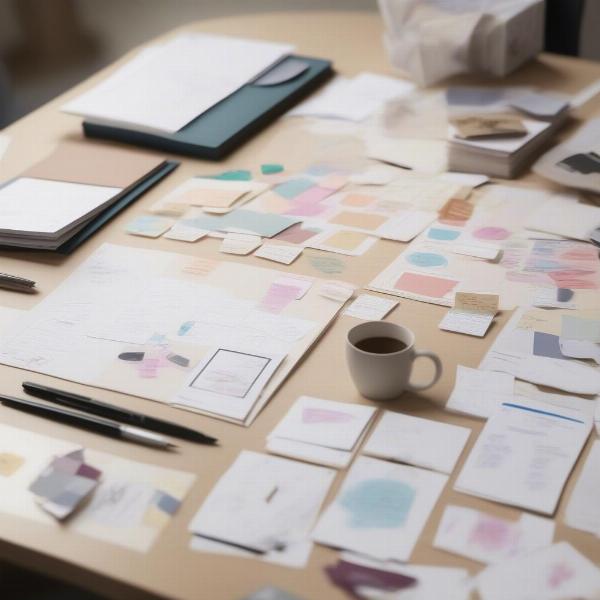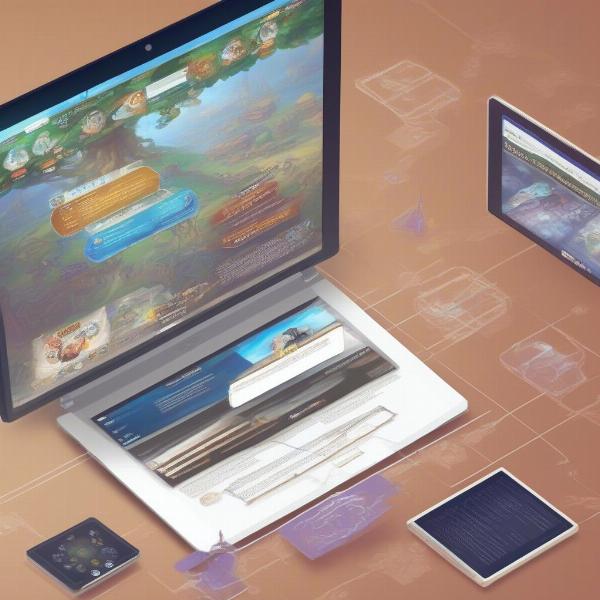Creating your own connections game, whether digital or physical, can be a rewarding experience. It allows you to tailor the gameplay and themes to your specific interests and share a unique creation with friends and family. This guide will walk you through the process of making your own connections game, covering everything from brainstorming ideas to designing the rules and even implementing it digitally.
Similar to how to play follow the leader game, connection games rely on established rules and understanding between players. Let’s dive into the key aspects of developing your own engaging connections game.
Defining Your Game’s Core Mechanics
The first step is to decide what kind of connections players will be making. Will it be based on matching colors, shapes, words, or something more abstract like concepts or ideas? The possibilities are vast. Consider the age and interests of your target audience. A game for young children might focus on simple color matching, while a game for adults could involve complex thematic connections. Think about games like Codenames or Dixit for inspiration. These games leverage the power of association and creative thinking to forge connections between seemingly unrelated elements.
What makes your game unique? Is it the theme, the complexity, or the specific type of connection players need to make? This is your chance to innovate and bring a fresh perspective to the connections game genre. Maybe your game is about connecting historical events, scientific discoveries, or even characters from your favorite book.
Developing the Rules and Gameplay
Once you have the core mechanic, it’s time to flesh out the rules. How do players take turns? How do they score points? What constitutes a valid connection? Clear and concise rules are essential for a smooth and enjoyable gaming experience. Consider different game modes to add replayability. Perhaps a timed mode, a cooperative mode, or even a competitive mode with varying difficulty levels.
How will players interact with the game? Will they be using cards, dice, a game board, or a digital interface? The choice of medium will significantly impact the gameplay and overall experience. For example, a card-based game offers portability and tactile interaction, while a digital game can incorporate multimedia elements and automated scoring.
 Designing Connections Game Cards
Designing Connections Game Cards
Creating the Game Components
This is where your creativity truly shines. If you’re making a physical game, you’ll need to design and produce the game components. This could involve creating cards, a game board, tokens, or any other physical pieces required for gameplay. Consider the materials, aesthetics, and overall presentation of your game. A visually appealing and well-crafted game will enhance the player experience. If you’re opting for a digital game, you’ll need to focus on user interface design, graphics, and programming.
Don’t be afraid to experiment with different art styles, fonts, and color palettes. The visual design of your game plays a crucial role in its overall appeal and can even influence the gameplay itself. Think about how the visuals can reinforce the theme and mechanics of your game.
Do you really know your family game online can give you some inspirations on digital family game implementation. While it’s a different genre, some core design principles can be applied to your connections game.
Testing and Refining Your Game
Before releasing your game to the world, it’s crucial to test it thoroughly. Gather a group of playtesters and observe how they interact with the game. Are the rules clear? Is the gameplay engaging? Are there any balancing issues? Feedback from playtesters can be invaluable in identifying areas for improvement and refining your game to its full potential.
Iteration is key. Be prepared to make changes based on feedback and continue testing until you’re satisfied with the final product. Testing should involve players of different skill levels and backgrounds to ensure a balanced and enjoyable experience for everyone.
 Playtesting the Connections Game
Playtesting the Connections Game
Digital Implementation (Optional)
If you’re tech-savvy, you can take your connections game to the next level by implementing it digitally. This opens up a whole new world of possibilities, from incorporating multimedia elements to automating gameplay and even creating online multiplayer functionality. There are various game development platforms and software available that can help you bring your digital connections game to life.
Consider using platforms like Unity or GameMaker Studio 2 for more complex games, or simpler tools like Scratch or Construct for less demanding projects. Learning the basics of game development can be a fun and rewarding experience in itself.
Sharing Your Creation
Once you’re happy with your game, it’s time to share it with the world! You can print physical copies, distribute it digitally, or even share it online for others to play. Consider creating a website or social media page dedicated to your game to build a community around it.
Sharing your creation can be a great way to connect with other game enthusiasts and get feedback on your work. Who knows, your connections game might become the next big hit!
How to play real lies game offers insights into sharing and promoting games within a specific community. While the game itself is different, the principles of community engagement can be applied to your own project.
 Sharing the Connections Game Online
Sharing the Connections Game Online
Expanding Your Game (Future Considerations)
Once your game is out there, you can continue to expand and improve it. Consider adding expansions, new game modes, or even creating a sequel. The possibilities are endless! Listen to player feedback and incorporate their suggestions to keep your game fresh and engaging.
Conclusion
Making your own connections game can be a challenging but ultimately rewarding experience. By following these steps and putting your own creative spin on it, you can create a unique and enjoyable game that you can share with others. So, what are you waiting for? Start brainstorming and let your imagination run wild! Remember, the most important thing is to have fun and create something you’re proud of. The world of connections games awaits your unique contribution. Now go make your own connections game!
FAQ
-
What are some examples of connection games? Codenames, Dixit, and LinkWords are popular examples of connections games.
-
What software can I use to create a digital connections game? Unity, GameMaker Studio 2, Scratch, and Construct are some options.
-
How do I test my connections game? Gather a group of playtesters and observe how they interact with the game, gathering feedback for improvements.
-
Where can I share my connections game? You can print physical copies, distribute it digitally, or share it online.
-
How can I make my connections game unique? Focus on a unique theme, mechanic, or level of complexity.
-
What are some important considerations for the rules of a connections game? Clarity, conciseness, and a balanced scoring system are crucial.
-
How can I expand my connections game in the future? Consider adding expansions, new game modes, or even creating a sequel.
Who killed Sam Westing in Westing Game offers a different perspective on mystery and puzzle-solving within a game narrative. This can be a source of inspiration for incorporating narrative elements into your connection game design.

